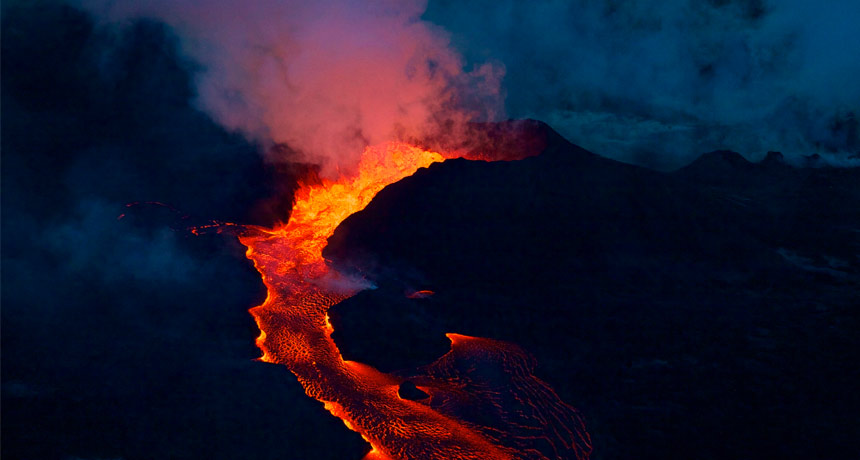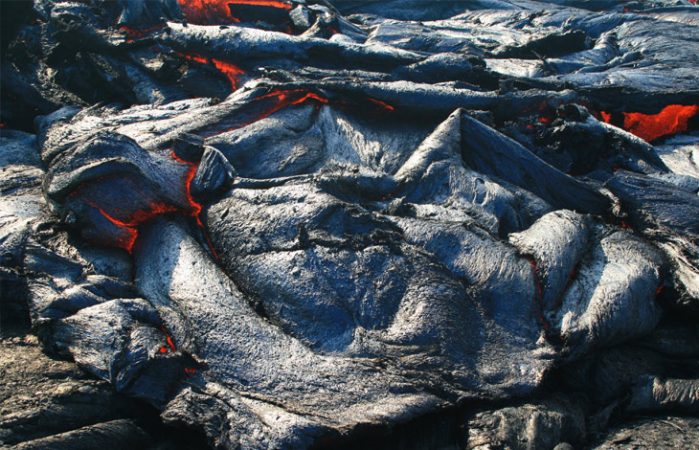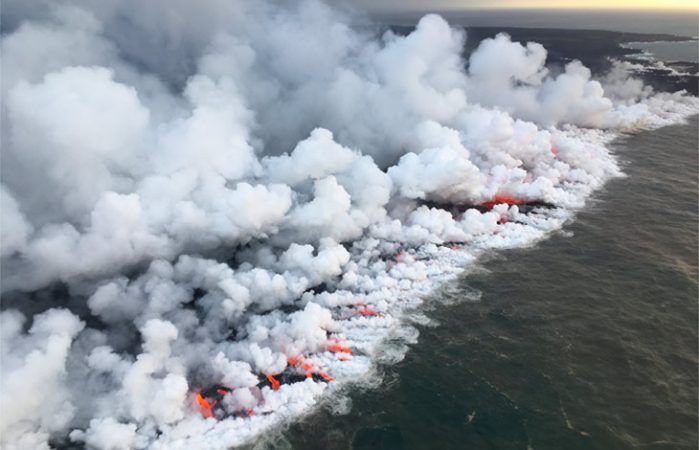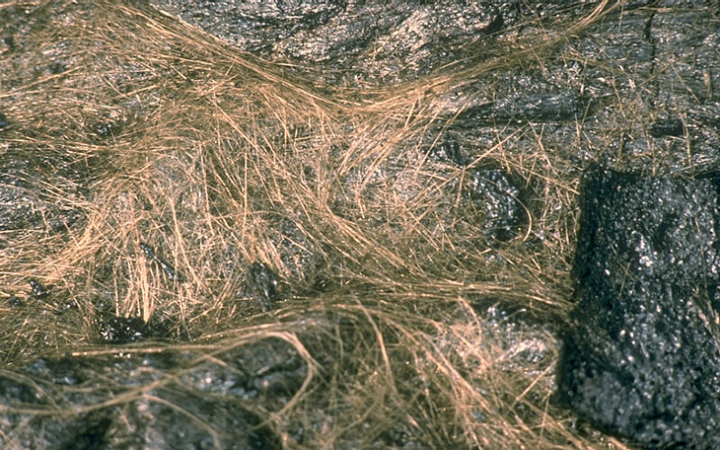Kilauea’s volcanic fireworks show no signs of stopping
From lavanadoes to laze and vog, the ongoing eruption is a lesson in volcano vocabulary

Fiery rivers of lava pour out of fissure 8 on Kilauea’s lower east rift zone. The lava fills an open channel from which it flows swiftly toward the ocean.
USGS
July 4th fireworks have nothing on Kilauea.
The Hawaiian volcano’s latest outburst has entered its third month . But scientists are still watching Kilauea 24/7. Such constant monitoring provides danger warnings aimed at keeping those nearby safe. It also offers remote viewers the rare opportunity to observe the evolution of an eruption in real time.
Magma within Kilauea’s summit crater — called Halema`uma`u — continues to drain and move toward the lower east rift zone. As a result, the crater floor has become increasingly unstable.
The U.S. Geological Survey has observed frequent rockfalls from Kilauea’s upper lip into the crater since mid-May. Each collapse triggers a small explosion. One of the largest explosions took place on June 30. That’s when a collapse-explosion cycle released energy equivalent to a magnitude 5.3 earthquake.
A “Whomp!” and a slow-rising cloud of volcanic gas and ash marked that collapse. But the real pyrotechnics are underway along nearly two dozen fissures. These are vents in that lower east rift zone through which lava is erupting. Lava fountains spurting from two fissures, Numbers 8 and 22, are feeding most of the lava flows that are now pouring into the sea.
It’s hard not to stare slack-jawed at images of molten rock spurting into the air. Or gape at glowing, fast-moving rivers of lava rushing into the ocean. Or gawk at the tangles of Pele’s hair — wispy-sharp strands of volcanic glass. Check out these highlights of Kilauea’s show and the science (and volcanic vocabulary) we’re learning from them:
Hot vortex
Of nearly two dozen fissures, Number 8 is producing some of the most spectacular pyrotechnics. This fissure is at the eastern edge of the now devastated Leilani Estates neighborhood. Among the more dramatic special effects that can emerge at sites such as this is the lava whirlwind, or lavanado. (The word is a combination of “lava” and “tornado.”) Lavanadoes form much like the “firenadoes” that are associated with especially intense wildfires. In each case, intense heat (in this case, from the volcano itself) causes air to rise swiftly, forming a tall column. Strong winds can then cause the column to rotate. The winds in this lavanado dance with the molten rock before flinging the lava several meters away.
In the vog
A thick fog has been curling out of fissures, then seeps along the ground. Called vog, this volcanic smog forms as sulfur dioxide and other gases and particles seep out from the fissures and react with oxygen, water vapor and sunlight. Since Kilauea began erupting along its lower east rift zone (within Leilani Estates), scientists have warned people nearby to wear protective masks. The goal is to guard against their breathing too much of this naturally toxic air pollution.
Ropy rock
The kind of lava erupting from Hawaiian volcanoes is a molten basalt rock. The lava cools into two main types of formation. When the lava flows slowly, air cools its “skin.” Beneath that skin, though, the lava continues to ooze ahead, advancing toe by toe. The smooth, ropy skin and toe-shaped lobes are characteristic of pahoehoe lava. More swiftly flowing lava is known as Aa. It appears chunky and angular. That’s because faster-moving lava loses heat more quickly and becomes more resistant to flow. Instead of a slow, sinuous advance, the lava tears ahead, forming large, hardened chunks.

Fast flow
Glowing torrents of lava fed by fissure 8 on Kilauea’s lower east rift zone jet through a channel at speeds of about 7.7 meters per second (17 miles per hour). Although USGS scientists shot this video June 19, the rivers continue to flow. Much like a river of water, lava moves most quickly through the center of a channel and more slowly along the edges. The reason: friction. Lava waves form as the molten rock sloshes through lava rapids, along its 13-kilometer (8-mile) journey to the sea.
On a boat
Also like many water rivers, lava rivers have occasional passengers. Lava boats are pieces of hardened lava that clump together and get carried downstream. These rafts of lava resemble boats on a waterway. As lava boats sail along, more pieces of cooling lava may glom onto them, boosting their size. These then form accretions called lava balls.
A huge chunk of lava, named a lava boat, sails away on a river of lava from the Kilauea eruption.
Ikaika Marzo/Facebook
Toxic steam
As Kilauea’s rivers of fire pour into the ocean, they boil the water. That sends great clouds of corrosive steam billowing into the air. The steam is a concoction that volcano scientists call laze, short for lava haze. It forms in a chemical reaction between the hot lava and seawater. At a temperature of about 1,150° Celsius (2,100° Fahrenheit), the lava basically boils away the seawater. That leaves behind very reactive sea salts (such as magnesium chloride). These salts react with the steam to form hydrochloric acid. Similar in strength to weak battery acid, laze can irritate eyes and skin. It can also cause breathing difficulties.

Glass hair
When tiny droplets of lava spray into the air and rapidly cool, they can form fine threads of volcanic glass. Those fine threads are known as Pele’s hair. Pele is the Hawaiian goddess of fire and volcanoes. The fibers are so fine that they can be carried along by the wind before raining out. But it’s not a gentle rain. The sharp threads are abrasive enough to scratch car windshields and can irritate skin and eyes, or contaminate open water reservoirs.

Kilauea continues to spew fire and reshape Hawaii. On July 16, a chunk of rock the size of a basketball flew out of a fissure near the ocean and hit a passing tourist boat. That “lava bomb” injured 23 people. Meanwhile, a new delta made from lava is filling in what was once Kapoho Bay. This lava delta now spans more than 162 hectares (400 acres), USGS scientists say. That’s the equivalent of more than 300 U.S. football fields. And the lava pouring into the ocean has even created a brand-new, tiny island just north of the bay.







